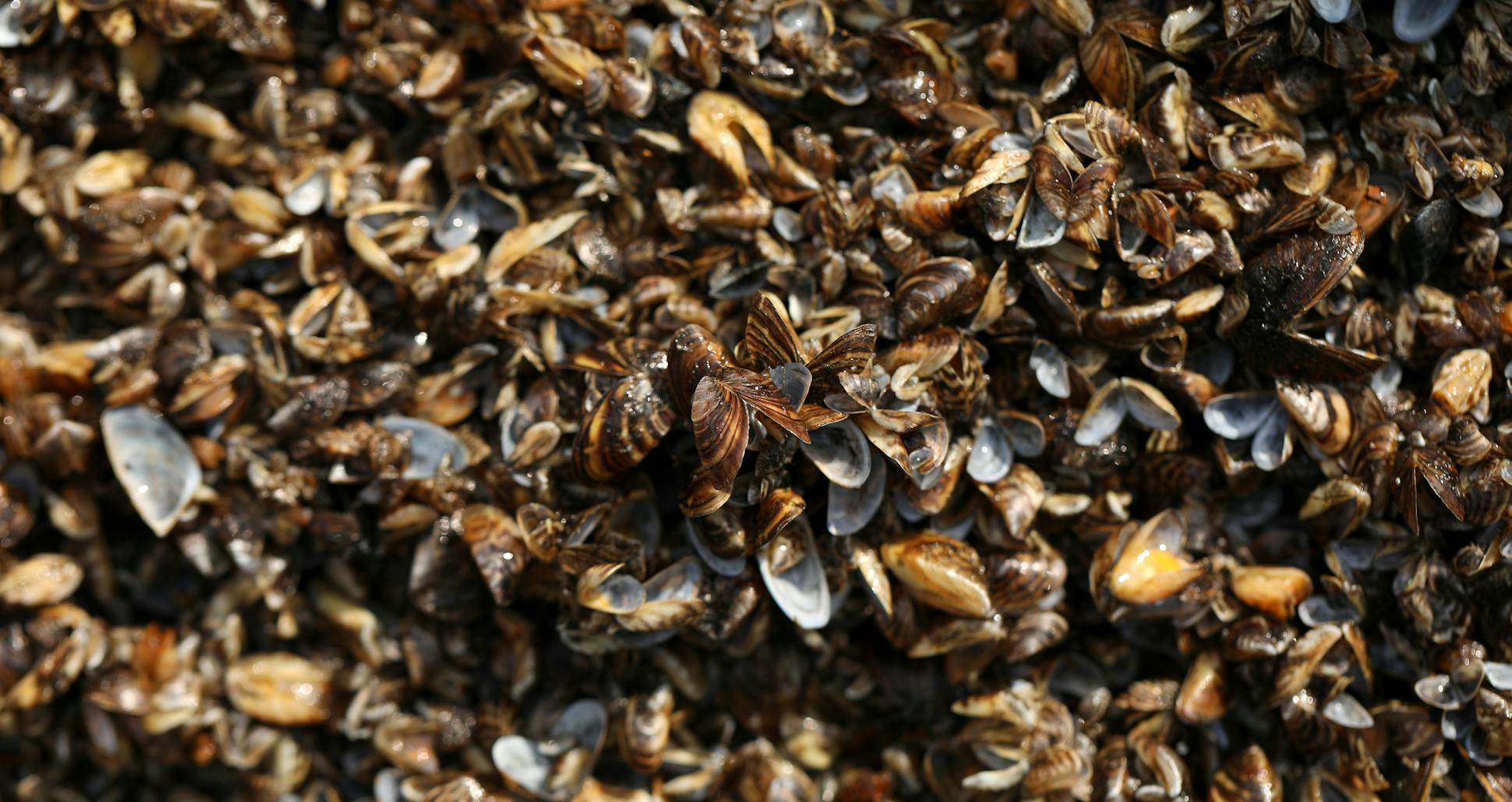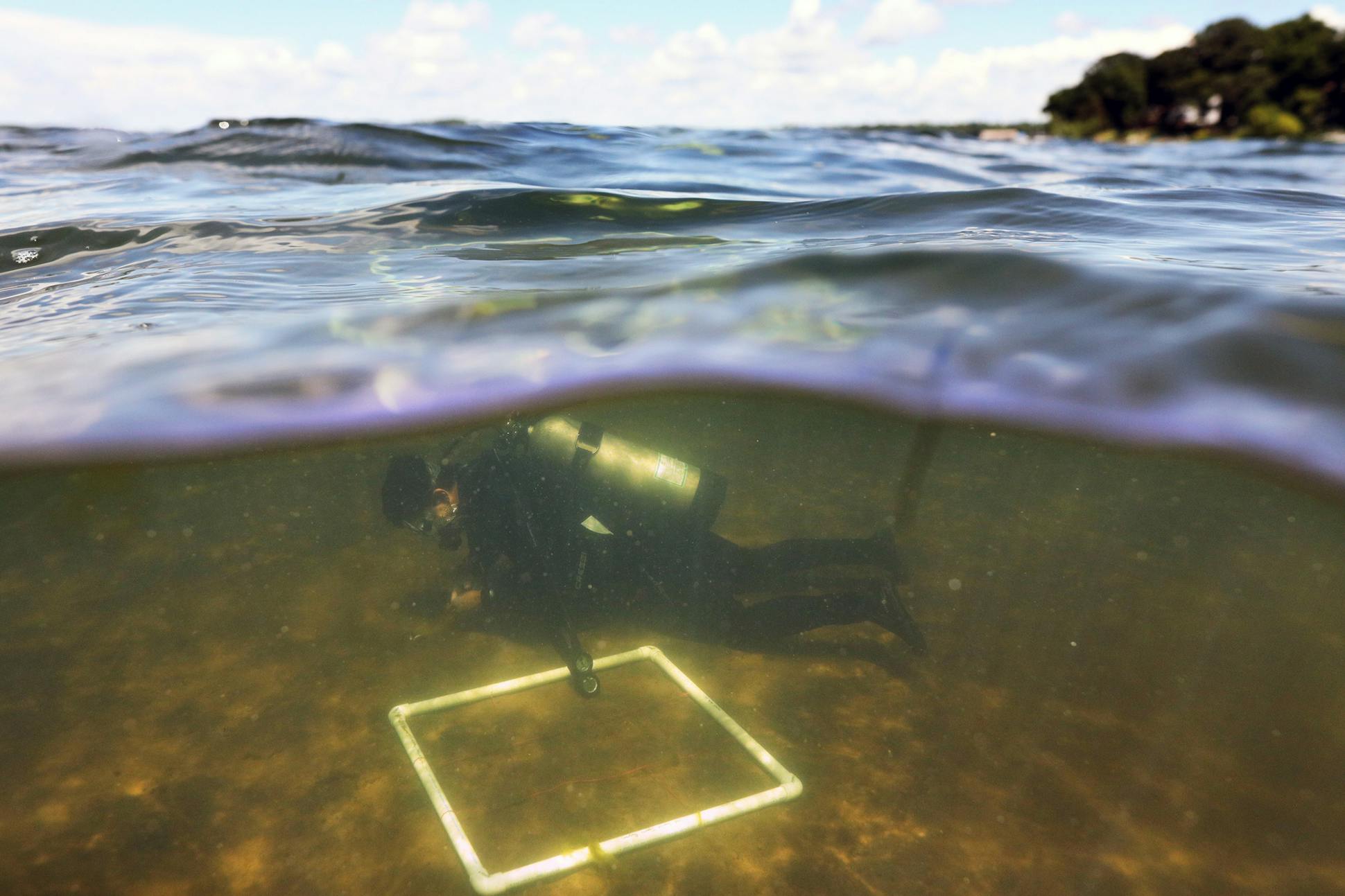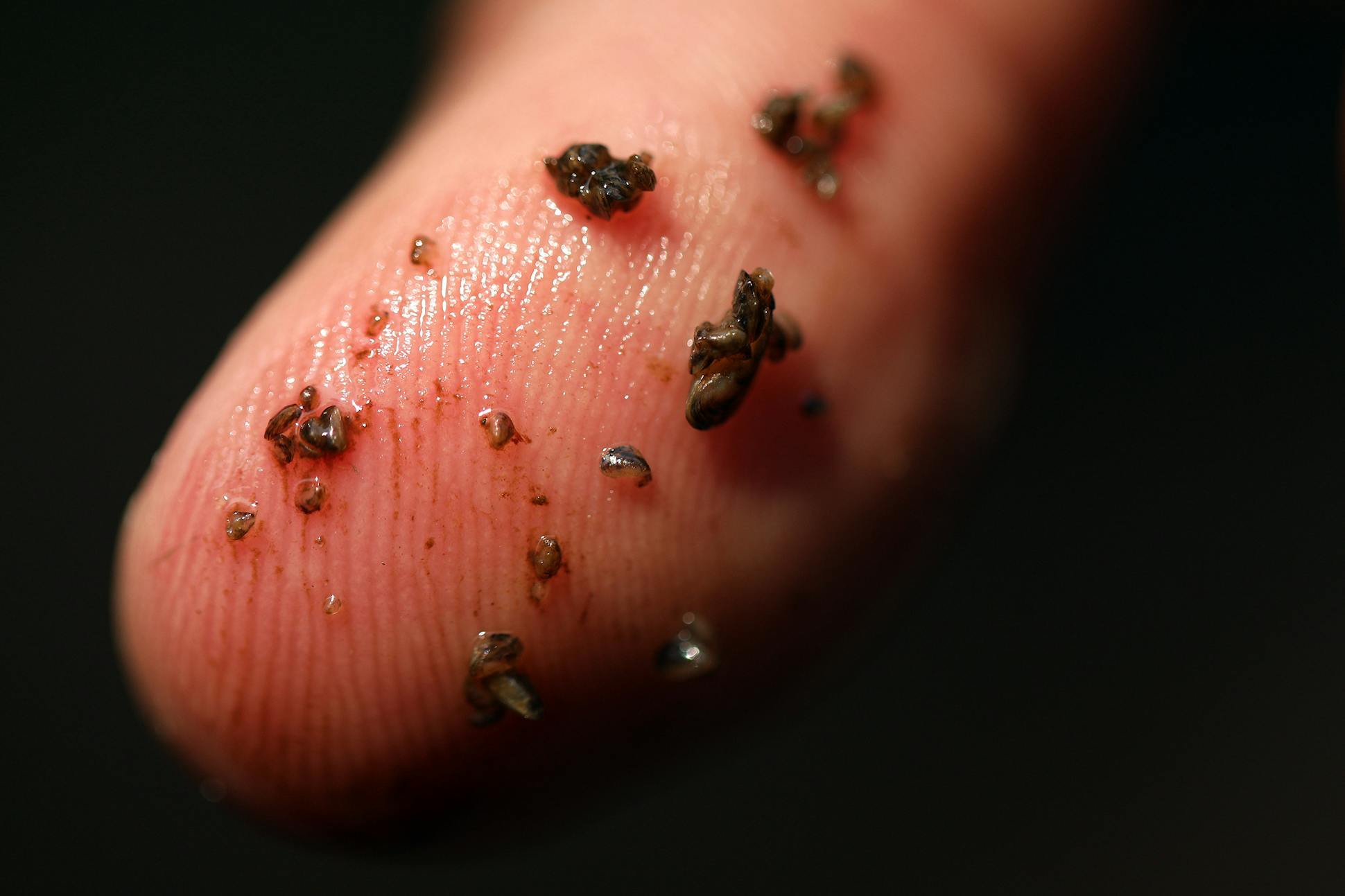Zebra mussels are invading and choking more of Minnesota’s lakes and rivers than ever - and their relentless advance poses a growing threat to our state’s way of life.
LAKE WINNIBIGOSHISH, MINN.
Summer after summer, Pat Rooney looked out at this revered North Woods lake, hoping the tea-colored waters that lured so many anglers also provided a magical barrier against a creature that might destroy it.
Zebra mussels already were fouling some of the biggest and best known waters in Minnesota, and were spreading throughout neighboring Cass Lake, a popular swimming, boating and fishing lake near Bemidji. While the larvae had appeared in "Lake Winnie," scuba divers repeatedly failed to find evidence of adult shells – the surest sign of infestation.
Then last August, a fisherman snagged a piece of driftwood encrusted with tiny, tiger-striped clams, and the biological clock began ticking on another Minnesota lake that is home to thousands of residents and visitors alike every year.
"Zebras were our nightmare,'' said Rooney, owner of Denny's Resort, a gathering place for walleye anglers since 1932. "Now they are here, and the problem is that you can't stop it.''
Zebra mussels are not the only invasive species appearing in Minnesota's waters, but their rapid spread poses an increasingly dire threat to the state's $5 billion-a-year summer tourism and fishing economy, as well as the cherished lake experience central to Minnesota's identity.
In Lake Pepin, so many zebra mussels inhabit the water that waves stir up millions of dead ones, dumping their razor-sharp shells on shore. An estimated 2 trillion zebra mussels occupy Lake Mille Lacs, where walleye fishing was banned at midsummer this year to protect dwindling fish stocks.
Zebra mussels last year debuted in more Minnesota lakes than ever, accelerating an outbreak that hasn't waned even in the face of mounting control efforts by state and federal agencies. Now zebra mussels graze in half the state's vaunted Big 10 walleye lakes – a group that has accounted for 40 percent of the statewide walleye harvest.
The thumbnail-sized mollusks spread rapidly, and silently but relentlessly upend the fragile ecology of a lake. They smother and kill native mussels. They strain out and consume tiny, edible material, robbing native fish of a fundamental link in the food chain. They excrete a carpet of waste that fosters the growth of hairy, stinky, toxic mats of algae.
The University of Wisconsin Sea Grant Institute warns that zebra mussels pose a multibillion-dollar threat to North America's industrial, agricultural and municipal water supplies. The U.S. Department of the Interior estimates yearly damages of $500,000 in the Great Lakes region alone. Federal and state agencies are spending tens of millions of dollars each year in a frantic and so far largely futile effort to kill them or halt their advance.
In Minnesota, the mussels have encroached on at least 275 lakes and rivers, and infiltrate another 20 to 30 new ones each year. Property value gains along some of those lakes are slowing or falling, posing a long-term economic threat to township and county treasuries in greater Minnesota.
"If we don't get our arms around this thing, we're going to regret it," said Jeff Forester, executive director of an association that represents about 6,000 Minnesota lake property owners.
Unwinnable war?
The havoc caused by zebra mussels is not limited to lakeshore property, boat engines, or drinking water supply lines in the Upper Midwest. Mussels are in Wisconsin, California, Texas, Louisiana and at least 20 other states besides Minnesota.
THE CHAOS THEY CAUSE
- Mussels are super-efficient feeders, siphoning out tiny plants and animals that are food for small fish.
- Walleye and pike sometimes turn to cannibalizing slow developing baby fish, further upending the food chain.
- Zebra mussels wreak havoc on infrastructure by clogging intake pipes for industrial water systems.
- They attach to boat motors and hulls, reducing performance.
- They devalue lakefront property.
- They attach to rocks, rafts and ladders, where swimmers can cut their feet on the shells' sharp edges.
- They erode the $5 billion-a-year summer tourism and fishing industry in lake regions.
- They create toxic algae.
Sources for all graphics: Minnesota Department of Natural Resources, USGS Nonindigenous Aquatic Species, Minnesota Sea Grant
On the shores of Lake Michigan, front-end loaders plow the mussels from impassable beaches. In Montana this summer, Glacier National Park imposed an unprecedented ban against private motorboats to keep zebra mussels away from the headwaters of three continental-scale watersheds. The ban is part of a collaboration just announced among 70 federal, state and tribal authorities targeting zebra mussels with a $9.7 million war chest this year and still more money next year.
In St. Paul, maintenance crews at the regional water utility battle zebra mussels hand to hand. Since 2007, when the intruders invaded Vadnais, Pleasant and Sucker lakes, workers have been forced to scrape them from screens on the utility's water supply lines as often as twice a week. And once a year, crews crawl half a mile into a large water delivery pipe to do similar work.
"It's awful and it smells terrible," said manager Jim Bode.
Removing the shells has added $140,000 a year to the utility's costs, tying up employees who have fallen behind on other work, Bode said.
In Minnesota, the task of stopping the zebra mussel outbreak falls mainly to the state Department of Natural Resources, which spends $10.5 million annually on combating all aquatic invasive species. The University of Minnesota partners closely with DNR, spending an additional $685,000 on zebra mussel research since January 2016. Counties and lake associations spend millions more every year on the same fight.
DNR officials believe growing public awareness, buttressed with a quartet of zebra mussel-sniffing dogs and stringent boat restrictions and inspections, can slow the spread of the voracious mollusks. They remain hopeful that cutting-edge research on the mussel's genome could identify a way to eliminate them altogether.
"I would love to eradicate these things," said Ann Pierce, DNR ecological and water resources section manager. "We are really making some progress."
Pierce acknowledged that the invasion is "getting more and more complicated as time goes on." But the fight is far from over, she said. "It's not the time to lay off."
Others are less optimistic. State Sen. Bill Ingebrigtsen lives in the Alexandria lakes region on Lake Ida, where zebra mussels are cutting the feet of his grandchildren. As chairman of the Senate's Environment and Natural Resources Finance Committee, he worries that the war against zebra mussels is no longer winnable.
"Frankly, I'm not sure we are going to stop them," he said. "They seem to go anywhere they want to go."
Price tag climbs
The barnacle-like shellfish have already tipped the biological scales in iconic Minnesota lakes such as Minnetonka, Pepin, Waconia, Gull, Leech, Cass, Pelican, Detroit, Whitefish, Miltona and Osakis. Infested rivers include the Mississippi, St. Croix, Zumbro, Pine and Minnehaha Creek.
In Mille Lacs, zebra mussels and invasive spiny waterfleas have combined to help collapse that lake's renown as a walleye fishing destination. Property values appear to be falling as angling restrictions rise, say county assessors.
"Certainly fishing is on people's minds when they buy here," Aitkin County Assessor Mike Dangers said.
The base land value on the Aitkin County portion of Mille Lacs is 26 percent lower than it was a decade ago, according to property records. The downturn coincided with the U.S. recession, but Dangers said values in other parts of the county – including shoreline lots around uncontaminated Big Sandy Lake – have recovered much faster.
Patrick Welle, a natural resources economic consultant and former Bemidji State University professor, said lakeshore properties lose about 16 percent of their value when the lakes are contaminated with invasive species.
Jim Davidson of St. Paul, who owns lakeshore property in northern Wisconsin, can see the day when some cabin owners try to sell their property before reporting zebra mussel infestations to authorities.
"It's pathetic you even think this way," he said.
THE SPREAD THROUGH EUROPE TO THE U.S.
Determined hitchhikers
Zebra mussels traveled to the U.S. from the Caspian Sea region in far eastern Europe, hiding in the ballast water of ocean freighters. They first took hold in water connected to Lake Erie in 1988, multiplying and spreading rapidly across Michigan, Illinois and other Great Lakes states.
Wisconsin got the mussels in 1989, and 260 of the state's 6,000 lakes and rivers are covered by the shellfish. Bob Wakeman of the Wisconsin DNR said the state's roster of contaminated lakes and rivers grows an average of 12 a year.
The first Minnesota zebra mussels, besides those plucked from a buoy in Lake Superior in 1989, arrived in the Mississippi and Lake Pepin in 1992.
A RAPID SPREAD
By 2003, zebra mussels had slingshotted north to Lake Ossawinnamakee on the edge of Breezy Point – the first Minnesota inland lake to be contaminated. Researchers believe the mussels journeyed via boat and trailer from Lake Pepin.
The DNR responded by heaving boulders into the channel between Ossawinnamakee and Kimball Lake, and treating the infested area with pesticides. But those preventive measures were called off in fall 2005 when Kimball became infested. A mere two years later, the mussels were sweeping across a latticework of regional beachheads.
Forester, the lakeshore property advocate, is among those who believe Minnesota was too lax in stopping the spread. "We could have kept them in Lake Pepin," he said.
In addition to threatening native species, zebra mussels clog water intakes at treatment facilities, electric and nuclear power plants and private industry.
Last year, water supervisors expanded their arsenal against zebra mussels when they received health department permission to apply an EPA-approved pesticide to water supplies. The St. Paul water utility will expand its use of the chemical treatment this year, Bode said. Even though it has been judged as safe for the treatment of source water, the agency said it will take precautions to ensure that no meaningful traces of the chemical reach the city's treatment plant.
The fight
Zebra mussels won't kill a lake. In fact, they make the water clearer. But they deplete the productivity and diversity of fish communities.
The mussels use their sticky, elastic tentacles to attach to gravel, rocks, underwater plants, docks, swimming rafts and boat hulls. If stepped on, their bladed edges can slice open a foot.
Some lakes may be less at risk of infestation because of water chemistry, exposure to sunlight or currents. Once established, though, the mussels gobble the nutrients from water they filter at the rate of 1 liter per mussel per day. The nutrients are essential to the livelihood of smaller, native organisms and forage fish in a lake, which in turn are the food supply of larger fish like walleye.
"A simple way to look at it is that they take out the base of the food web," said Mike McCartney, lead zebra mussel researcher at the Minnesota Aquatic Invasive Species Research Center. "People should be freaked out a little."
The mussels reproduce at an alarming rate. A single female zebra mussel can produce a half billion adult offspring in her lifetime. In three to five years, beds of adult mollusks often coat bottom areas of a lake or river.
McCartney and a cohort of DNR experts say fighting the mussels is not a lost cause. Research should be accelerated, they say, because – as bad as the state's infestation is – fewer than 5 percent of Minnesota lakes are currently contaminated.
Watercraft inspections will remain critical, McCartney said, as will improved detection methods and more pesticide trials. If there's good news, it's that the tiny invaders aren't spreading as fast in Minnesota as they are in less-vigilant states.
Efforts to eradicate them, however, have so far proven fruitless and costly.
Joe Schneider, a resident of Christmas Lake in the west metro, witnessed the resiliency of zebra mussels in 2014, when a trio of lethal toxicants seemed to snuff out an isolated colony of the mussels during a DNR trial not far from his house. The $60,000 experiment ended when the creatures reappeared outside the kill zone.
"It's literally like a cancer," said Schneider, who favors an intensified fight against the mussels for the sake of other Minnesota lakes.
Christmas Lake residents now pay $80,000 a year, privately, to keep out other invasive species and to prevent the outward movement of zebra mussels. Their money underwrites long hours of boat and trailer inspections at the Christmas Lake boat ramp.
At a U.S. Geological Survey center in La Crosse, Wis., federal zebra mussel researchers Jim Luoma and Chris Merkes are experimenting with other poisons and gene warfare. They say public pressure for a scientific solution keeps funding alive.
"We do what Congress wants us to do," Merkes said.
DNA tracking
At the U, supercomputers have been enlisted to identify the most frequent overland paths traveled by genetically distinct clusters of the mollusks.
Groups of mussels with matching genotypes have been found in the Brainerd-Nisswa area, while other zebra mussel families have contaminated pockets of lakes around Detroit Lakes and Alexandria.
Becca Nash of the U's Aquatic Invasive Species Research Center said the findings call for more efforts to block the spread of mussels within regions. The same research, she said, is disproving theories that Mille Lacs and Prior Lake are "super spreaders." In the surprising case of Mille Lacs – highly trafficked by transient fishing boats – its unique strain of zebra mussels has never been found in another lake.
"It makes us think that boat inspections and decontamination are working," Nash said.
Counties and lake associations also are taking a more aggressive role in preventing their spread, changing the state's boating culture in the process.
In the past three years alone, the number of trained, publicly funded inspectors has increased tenfold to more than 1,100 with the help of state money allocated to counties.
"Once you lose the balance of a healthy lake, you never get it back," said Rima Smith-Keprios, who heads zebra mussel prevention in Cass County, where lakes tourism is a $100 million-a-year industry. "People around here are concerned. We don't want to be like Mille Lacs."
At some lakes, preventive efforts occur all day, every day. As boaters approach launch ramps on Roosevelt and Ten Mile lakes in Cass County, their movement sets off an electronic eye. While a video camera rolls, a voice greets the boaters and reminds them to clean and drain their equipment.
"Some of the reactions are priceless," said Smith-Keprios.
The digital sentries belong to a growing AIS-prevention movement that melds volunteerism, the passion of lake associations, county leadership, DNR expertise and $10 million a year in state funding.
As the third-largest recipient of the money, Cass County this year will receive $510,000 – enough to employ 32 seasonal boat inspectors, up from seven in 2014.
The initiative has sparked new education efforts, encouraged new pilot projects with lake associations, paid for portable decontamination units and greatly boosted the number of trained watercraft inspectors.
Last September, for example, Cass County, the DNR, the Army Corps of Engineers and Muskies Inc. collaborated to require 500 participants in the three-day Frank Schneider Jr. Annual Muskie Tournament to turn in signed inspection cards before dipping their boats into local waters.
To minimize possible zebra mussel movement, contestants also agreed to fish within one of four lake zones in areas supported with decontamination services and well-staffed by inspectors.
"We still have pristine lakes and they should be shielded," Smith-Keprios said.
Buying time
HOW THEY GROW AND COLONIZE
Even though zebra mussels start off microscopic, they can grow up to 1 ½ inches. With females producing hundreds of thousands of eggs per year, these colonies can grow big enough to take over an environment.
Officials and residents in Hubbard County, including those in its largest city, Park Rapids, dreaded the economic peril posed by zebra mussels to the county's 250 lakes.
An auditor's report estimates that 60 percent of total taxable land value in Hubbard County derives from lake property. And in the county's top seven tax-generating townships, 70 to 87 percent of property value is lake-related.
The data prompted widespread support for a prevention campaign financed by $500,000 in donations from area lake associations and townships. Additionally, residents volunteered to inspect watercraft and educate the public. State taxpayers pay to keep the program going.
Hubbard County now is a rare bright spot in Minnesota, with all of its lakes free of the Big Four invasive species in the state: zebra mussels, spiny waterfleas, starry stonewort (thick algae) and Eurasian watermilfoil.
"The economy here depends on water quality," said Ken Grob, who founded the coalition.
McCartney, the U researcher, said people tend to disregard control efforts such as these, believing that an all-out spread of zebra mussels is inevitable. But so far, he said, efforts like those in Hubbard County and elsewhere appear to be working.
Keegan Lund, an aquatic invasive species specialist with the DNR, said that while attempts continue to limit the expansion of zebra mussels, chemicals hold some promise in the fight against further infestations.
The state's biggest poisoning was launched late last year in a 29-acre area of Lake Minnewashta in Carver County. A copper chemical was unloaded on the bay last fall, seemingly killing the target. Surveillance this year will tell whether the mussels regroup.
"There's very little experience around the country at controlling them … so we're basically writing the book," Lund said.
DNA sequencing of the mussel's genome could also accelerate the development of genetic and biological agents that might prevent or eliminate the mussels altogether.
"That's why it's important for us to slow it down," said John Ringle, director of environmental services in Cass County. "We're buying time."
Up north, on the shores of Lake Winnibigoshish, resort owner Rooney acknowledged that a lot of people ask whether his lake will end up like Mille Lacs. He holds out hope that Lake Winnie's sandy bottom will provide fewer hard surfaces for zebra mussels to attach themselves.
Still, Rooney cringed this winter at his first encounter with the lake's new invader.
While ice-fishing for walleyes, he reeled up a Chinese mystery snail, a harmless crustacean commonly found in the lake.
The snail was caked with young zebra mussels.







